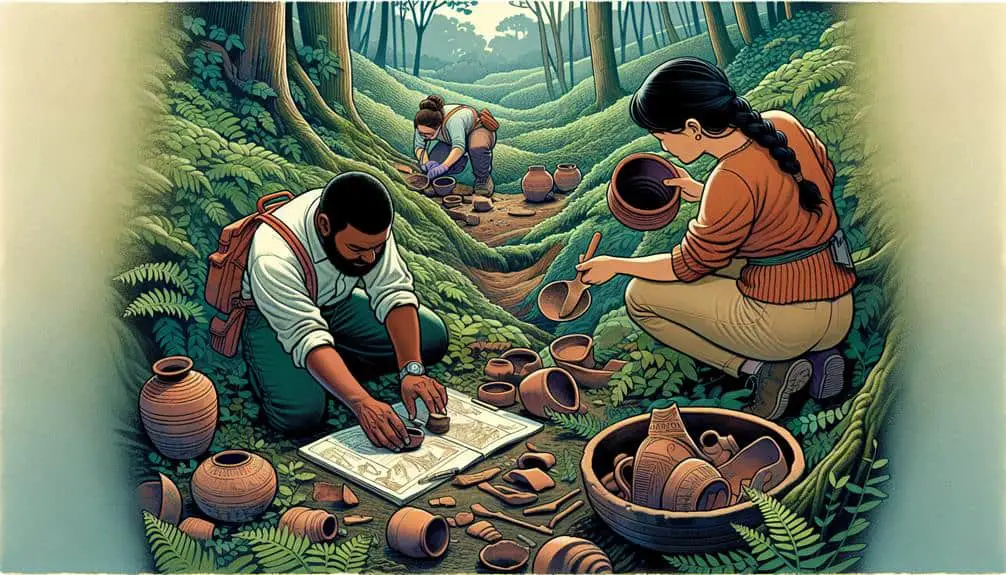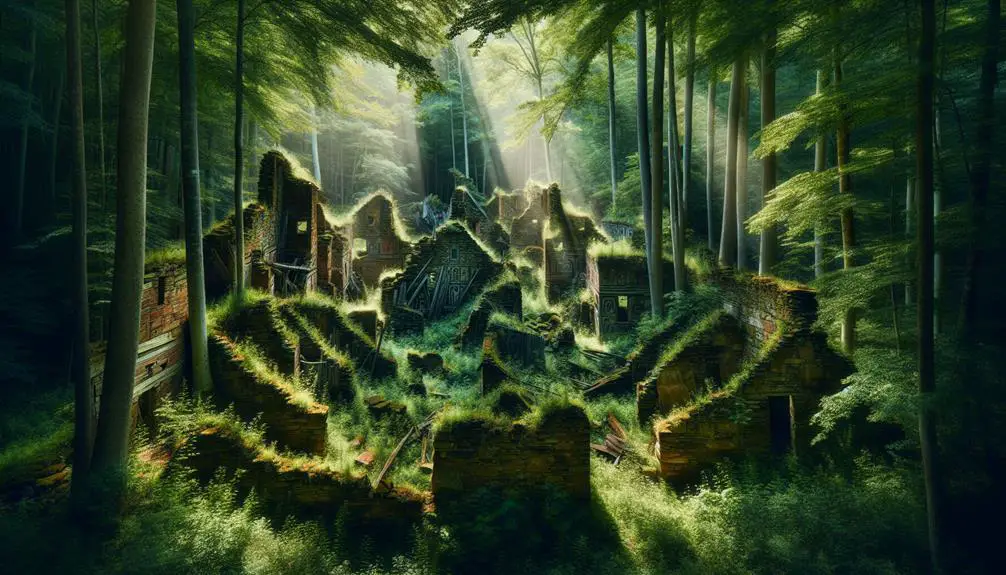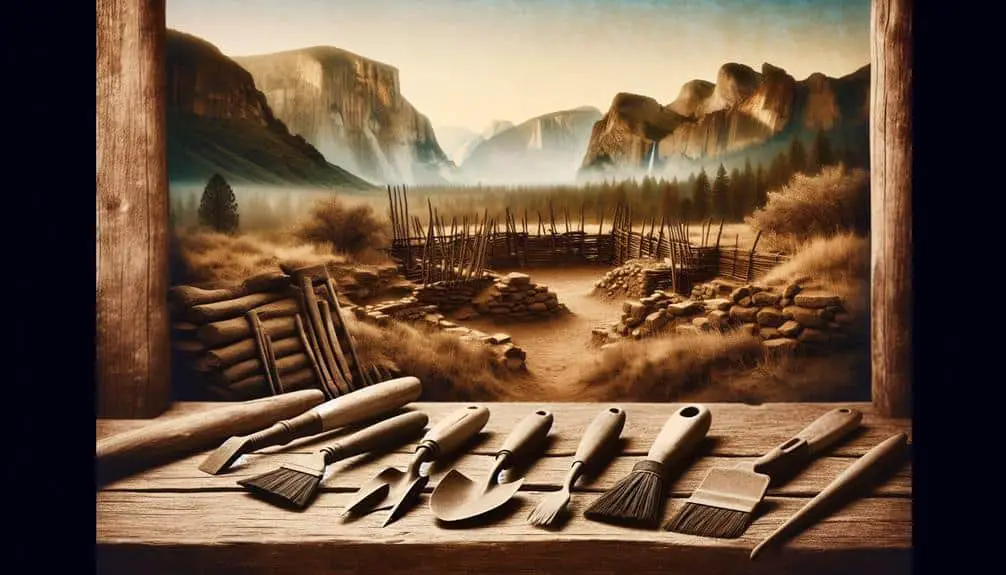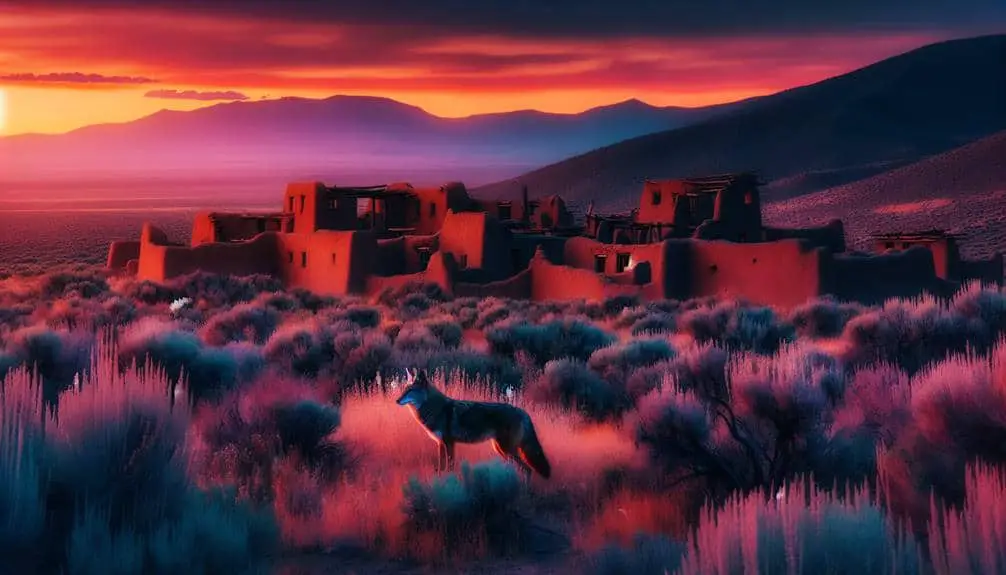Step into the world of ancient Native American towns and explore a treasure trove of historical insights. Uncover pottery shards, tools, and street layouts that offer a peek into past craftsmanship and urban planning. Personal items and food remains provide clues about fashion styles and dietary habits. Investigate how these ruins illuminate daily activities and societal structures. Dive deeper into the preservation efforts and cultural significance of these ancient settlements. Each discovery reveals a unique story waiting to be unraveled, enriching your understanding of the past.
Key Points
- Native American ruins reveal rich cultural heritage and historical insights.
- Archaeological discoveries in ghost towns provide clues about past craftsmanship and urban planning.
- Preservation efforts for ancient settlements balance conservation and accessibility.
- Cultural insights from ancient town remnants offer valuable understanding of lifestyles and traditions.
- Tourism impact on Native American sites brings economic benefits but requires responsible approach.
Significance of Native American Ruins
Exploring the significance of Native American ruins reveals a rich tapestry of cultural heritage and historical insights waiting to be uncovered. These ancient ruins hold immense cultural significance, offering a glimpse into the lives, beliefs, and practices of the Native American civilizations that once thrived in these areas. The structures, artifacts, and symbols found within these ruins provide valuable clues about the daily lives, social structures, and spiritual beliefs of these ancient peoples.
Moreover, the historical importance of Native American ruins can't be overstated. These sites offer a unique opportunity to study the evolution of human societies in North America, tracing the development of various cultural groups over centuries. By examining the layout of the settlements, the types of tools and pottery used, and the artwork present, historians can piece together a thorough understanding of the past. Each ruin tells a story, shedding light on the complexities and diversity of Native American history. Through careful exploration and analysis, these ruins continue to enrich our knowledge of the past, preserving an essential part of our shared heritage for generations to come.
Archaeological Discoveries in Ghost Towns
Archaeologists uncover a wealth of historical artifacts and insights in the abandoned streets and dilapidated buildings of ghost towns, offering a fascinating glimpse into the lives of past inhabitants. Exploring artifacts left behind in these forgotten civilizations sheds light on the daily activities, societal structures, and cultural practices of ancient communities.
- Unearthing pottery shards and tools provides clues about the craftsmanship and technologies of the past inhabitants.
- Studying the layout of streets and buildings helps reconstruct the urban planning and social organization of these ancient settlements.
- Analyzing food remains and cooking implements offers insight into the diet and culinary traditions of the people who once inhabited these towns.
- Discovering personal items like jewelry and clothing accessories gives a glimpse into the personal adornment and fashion styles of the ancient residents.
Preservation Efforts for Ancient Settlements
To guarantee the preservation of ancient settlements, meticulous planning and strategic interventions are imperative to safeguard these invaluable historical sites for future generations. Community engagement plays an important role in the preservation efforts of ancient settlements. Involving local communities in decision-making processes fosters a sense of ownership and pride, making sure that these historical sites are valued and protected.
Historical restoration is another key aspect of preservation efforts. By employing experts in archaeology, architecture, and conservation, ancient structures and artifacts can be carefully restored to their former glory, allowing future generations to appreciate the rich history of these settlements.
Preservation efforts for ancient settlements require a delicate balance between conservation and accessibility. Implementing measures to protect these sites from environmental damage, vandalism, and over-tourism is essential. By creating sustainable tourism practices and limiting visitor numbers, we can guarantee that these ancient settlements remain intact for years to come.
Through a combination of community engagement and historical restoration, we can work together to preserve the legacy of ancient Native American towns for future generations to learn from and enjoy.
Cultural Insights From Ancient Town Remnants
Studying the remnants of ancient towns provides valuable cultural insights into the lifestyles and traditions of early Native American communities. Exploring these archaeological sites can offer a glimpse into the rich cultural practices and societal structures of these ancient civilizations.
Here are four intriguing aspects that can be gleaned from these town remnants:
- Community Layout: The way in which houses, communal areas, and ceremonial spaces are arranged can reveal insights into social organization and interactions within the community.
- Artifact Discoveries: Unearthing tools, pottery, and artwork can shed light on the daily activities, craftsmanship, and artistic expressions of the inhabitants.
- Food and Agriculture: Examining remnants of fields, storage facilities, and cooking areas can provide clues about the agricultural practices and dietary habits of the community.
- Ceremonial Sites: The presence of specific structures or artifacts associated with rituals and ceremonies can offer a glimpse into the spiritual beliefs and practices of the ancient inhabitants.
Tourism Impact on Native American Sites
The influx of tourists to Native American sites has greatly impacted the preservation and management of these culturally significant locations. When managed effectively, tourism can bring economic benefits to Native American communities through increased jobs, revenue from entrance fees, and the sale of culturally authentic goods. However, an imbalance between preserving the site's integrity and catering to tourists' demands can arise. This delicate balance requires thoughtful planning and collaboration between tribal authorities, heritage experts, and tourism agencies.
Cultural exchange is a vital aspect of tourism at Native American sites. Visitors have the opportunity to learn about the rich history, traditions, and beliefs of Indigenous peoples, fostering mutual respect and understanding. Conversely, Native communities can share their knowledge and stories, ensuring that their heritage is accurately portrayed and respected. By engaging in meaningful cultural exchange, tourists can leave with a deeper appreciation for Native American history and a desire to support ongoing preservation efforts. Ultimately, the tourism impact on Native American sites can be positive when approached responsibly and with a focus on mutual respect and understanding.
Frequently Asked Questions
What Methods Do Archaeologists Use to Date Ancient Native American Ruins?
To date ancient Native American ruins, archaeologists utilize various methods. Radiocarbon dating and dendrochronology provide precise timelines. Excavation techniques and stratigraphy help uncover layers of history. These tools reveal the rich past of indigenous civilizations.
How Were Ancient Native American Towns Structured and Organized?
Ancient Native American towns were organized based on social hierarchy, influencing architectural design. Leaders often resided in central locations, with surrounding areas designated for different social groups. This structured layout reflected the community's values and organization.
What Role Did Trade Play in Connecting Different Native American Settlements?
You might not realize it, but trade routes were the lifeblood of ancient Native American settlements. Through economic relationships and social networks, these pathways facilitated cultural exchange and connected different communities, shaping their identities.
Are There Any Oral Traditions or Legends That Provide Insight Into the History of These Ancient Towns?
Explore the tapestry of oral traditions woven through generations, shedding light on ancient towns' history. While legends captivate with cultural significance, archaeological evidence validates their historical accuracy, providing a multifaceted glimpse into the past.
How Have Modern Native American Communities Been Affected by the Preservation and Study of Ancient Settlements?
In modern Native American communities, the cultural impact of preserving ancient settlements is profound. However, it brings challenges in maintaining authenticity amidst development pressures. Balancing heritage and progress is a delicate dance for these communities.



